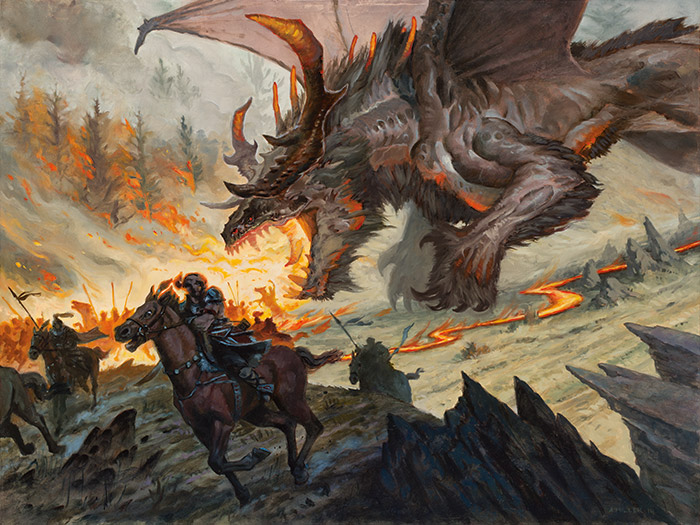Planeswalker's Guide to Dragons of Tarkir, Part 1
This is the first of two Planeswalker's Guide that describe Tarkir as it exists in Dragons of Tarkir.
A World Ruled by Dragons
If this were a different present, Tarkir would be in the clutches of five powerful khans. The deserts and the forests would be rife with bloodshed and plagued by war. The clans would be locked in battle for control of immense fortunes and vast kingdoms. But this is not that present. This present was never the khans' to rule. This present belongs to the dragons.
Art by James Ryman
The mighty dragons of Tarkir owe their existence to the Planeswalker Sarkhan Vol. From a dragonless present, he traveled back in time more than a thousand years to a crucial turning point, and there he saved Planeswalker Ugin, the Spirit Dragon, from death. In doing so he ensured the continuing presence of the dragon tempests, the storms that feed on Ugin's magic and the source of all dragons on Tarkir.
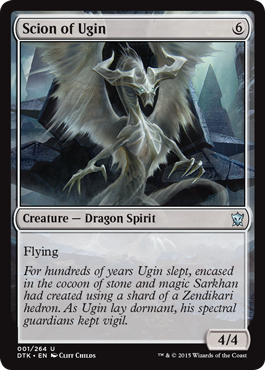
For many years, the clans fought a war against the dragons for their own survival, hoping to gain some advantage in the struggle. With the dragons' presence secured by Sarkhan's actions, draconic numbers grew, and soon the tide of the war turned. Ultimately, the dragons were able to hunt down the khans and destroy them. Then all that was left was for the dragons to claim their place on the vacant thrones of Tarkir.
History of Tarkir
The Khanfall. The khan-led clans fought the dragons as best they could. But one by one, each of the ancient humanoid khans fell, and their clans fell with them—an event more than a thousand years ago that is now known as the Khanfall. In place of the old humanoid clans rose the five dragon clans, named after their dragonlords: the elder dragons Dromoka, Ojutai, Silumgar, Kolaghan, and Atarka.
Art by Aaron Miller
Fate of the Humanoids. The dragon clans did not wipe out all of the humanoid races. After the khans were defeated, the dragons turned their attentions to each other. The dragons allowed humanoids to follow and support them in their struggle against one another, forming five new dragon-led clans. Almost all humanoids now live as part of one of these five clans, serving a variety of purposes for their dragon overlords. Life can be hard in the dragon clans; the highest-ranked humanoid still ranks lower than the lowest-status dragon. Still, membership is still the safest life for humanoids. This is the world that Sarkhan's actions created: a world where dragons truly rule. Even Zurgo—the Mardu khan in Sarkhan's original timeline—must bow to a dragonlord.
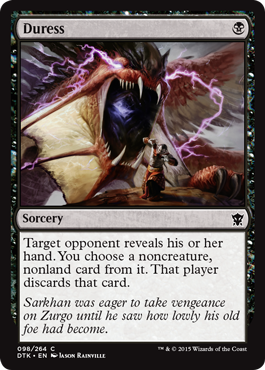
Draconic Clans of Tarkir
In this present, the defeated clans are ruled by five legendary dragonlords. Over time, the clans have come to embody the predominant aspects of their draconic masters and they represent these strengths with draconic symbols. Each clan bears the name of its dragonlord and represents the corresponding draconic aspect: Endurance, Cunning, Ruthlessness, Speed, and Savagery.
The Draconic Language. The dragons speak a language unique to their kind. Although many dragons can speak the common tongue, they choose not to except in very rare circumstances.
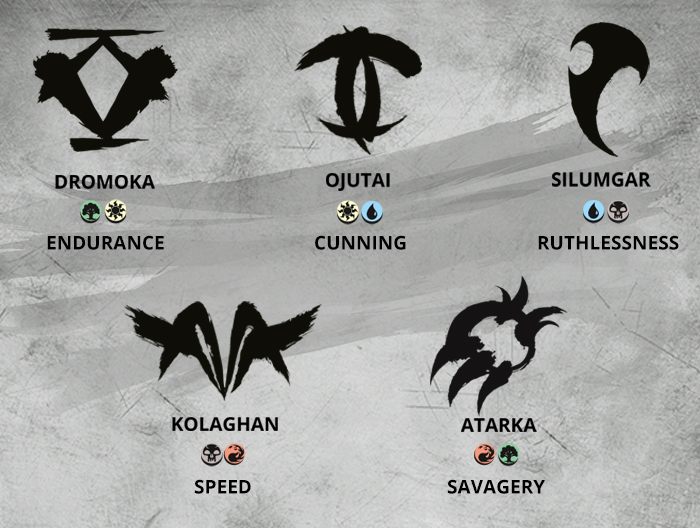
The Ojutai Clan
Clan Overview
While most on Tarkir bow to their overlords out of fear or awe, the monks and mystics of the Ojutai clan submit out of respect and a desire for knowledge. The clan seeks to learn how to truly embody the draconic aspect of cunning and has taken the dragon's eye as a symbol to represent this quest for enlightenment.
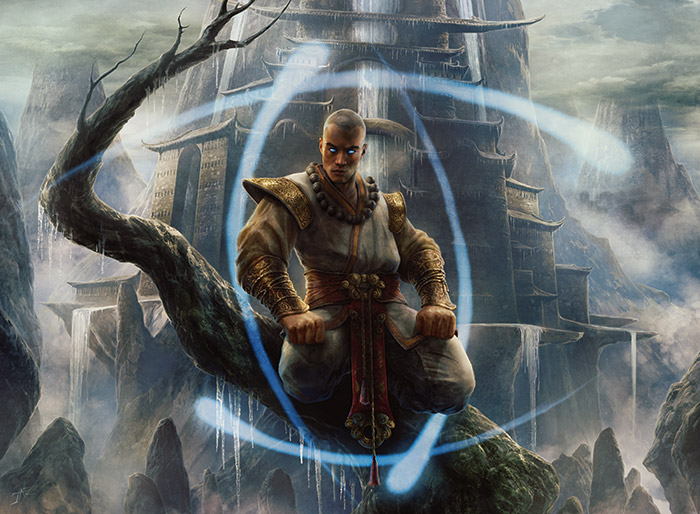
Art by Jason A. Engle
The Ojutai accept that there is a limit to the wisdom they can achieve in their short lifetimes. The dragons they revere, however, live much longer, and thus the clan believes these overlords deserve the honor that comes with the name of skywise. One of the greatest achievements for an Ojutai is to attract the personal notice and attention of an esteemed skywise; it is then expected that any and all teachings the dragon has to offer will be greedily devoured.
Ojutai orthodoxy holds that the dragons do not rule the clan, but rather guide those who serve them to a greater understanding of the world. Above all else, those in the clan value the benefits they reap thanks to the wisdom of their leaders. Accordingly, any who deviate from the teachings of Ojutai and his disciples are seen not as political dissidents, but as heretics following a false path to enlightenment. Such sacrilege is swiftly and brutally punished.
Dragonlord Ojutai
The dragonlord known as Ojutai is ancient, insightful, and wise. The truth of how he came to dominate the clan that bears his name has been lost in the mists of history. His own teachings dictate that the other dragons in the brood voluntarily bowed to him, submitting to his age and wisdom. None in the clan dare dispute that claim, despite what some might privately believe.
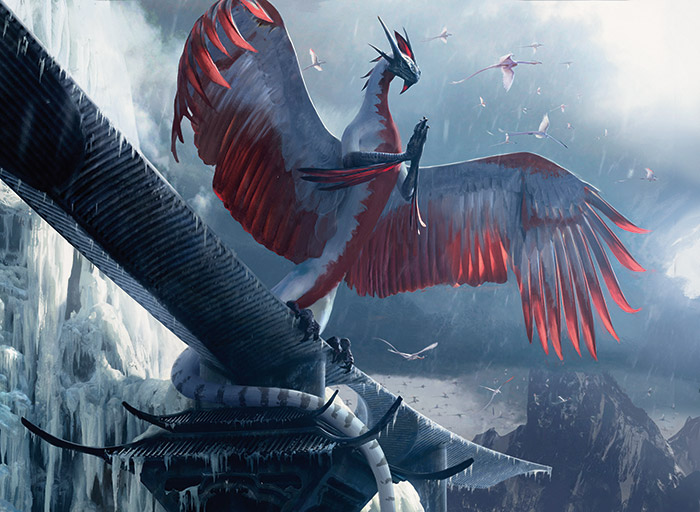
Art by Chase Stone
Known as the Great Teacher, Ojutai spends long afternoons in his roost at Dragon's Eye Sanctuary, holding forth on spiritual and intellectual affairs. His audience consists almost entirely of dragons; others are seldom permitted to have direct contact with the esteemed dragonlord. Lesser beings aren't even trusted to transcribe the Great Teacher's words, as it is accepted that they will never truly master the complexities of the draconic language.
Clan Values
Guidance of the Skywise. The Ojutai respect age, wisdom, and martial strength—traits that humanoids might possess, but that dragons exemplify. Many clan members refer to dragons as honored ones, and those they consider noble—especially their own dragon masters—they name the skywise. For a humanoid, attracting the personal notice of a dragon teacher is a great achievement. Doing so before middle age is almost unheard of.
The Great Wheel. Clan members believe that souls are reincarnated in a cycle known as the Great Wheel. Ojutai teaches that the least among dragons is wiser and more powerful than the greatest of humans, just as the least among humanoids is wiser and more powerful than the greatest of mice. Thus, the goal of each soul on the Great Wheel is to attain the highest possible form of existence by being reborn as a dragon.
This belief suggests that the souls of dragons were once the souls of humanoids, but former lives in general—and those of dragons in particular—aren't considered a topic for polite conversation. It's borderline blasphemous to speculate that a particular dragon might be the reincarnation of a particular humanoid. Nonetheless, after the death of a widely respected monk, many Ojutai followers quietly look for signs of his or her reincarnation in subsequent draconic storms.
The dragonlord Ojutai is considered to exist outside the Great Wheel. Dogma states that the dragonlord was born in the first storm, already perfect and eternal, ready to impart his wisdom to lesser beings.
Clan Structure
Monastic Sanctuaries. The clan is organized into a series of loosely connected temple complexes known as sanctuaries. Each is self-sufficient and self-organized, with leadership based on seniority and scholarly accomplishment. Most sanctuaries are small and have no permanent dragon inhabitants, consisting mostly of humans and ainok with some itinerant aven and djinn. The largest have standing populations of dragons, and the most promising students from other sanctuaries are sent to study there. Dragon's Eye is the greatest sanctuary, where Ojutai resides.
The Ojutai are as much a monastic order as a clan; leadership is earned by martial prowess and spiritual teaching rather than by heredity. Each humanoid member of the Ojutai holds both a martial rank and an academic rank. Any given individual may pursue either or both, and the two exist in parallel. The highest-ranked martial artist in a sanctuary commands that sanctuary's fighters, and the highest-ranked scholar teaches and leads the sanctuary in peacetime. On rare occasions and in smaller sanctuaries, the same person may hold both positions.
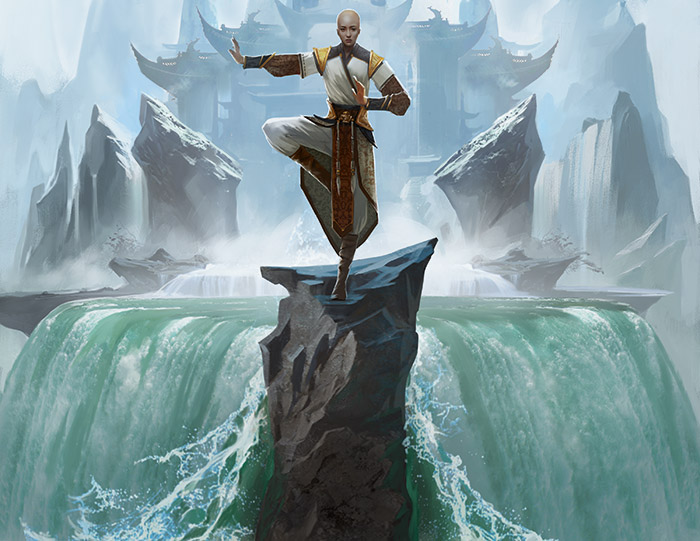
Art by Anastasia Ovchinnikova
Clothing among the Ojutai humanoids is humble, growing more elaborate as rank increases. Leaders, particularly scholars, dress very ornately. In part, this custom helps the dragons tell who's in charge without having to inspect the minute details of humanoid faces.
The Great Teacher remains largely aloof from the day-to-day affairs of the clan. He is concerned with enlightenment and teaching, not with the mundane details of humanoid society.
Draconic, the Language of Scholars. Everyday business among the Ojutai is conducted in the human vernacular, and younger learners are permitted to study translations of the Great Teacher's lessons. True scholarship, however, requires understanding, reading, and speaking the language of dragons. Ojutai delivers his teachings in Draconic speech, and their true meaning might be obscured in lesser tongues. Most humanoids among the Ojutai can understand Draconic to some degree, although it is often considered taboo to read or speak Draconic unless taught directly by one of the skywise.
Many can understand at least the basic spoken language, particularly when the dragons enunciate slowly and clearly for their benefit. Relatively few can understand the complex spoken Draconic used in intense spiritual debates. Only a handful of humanoids can actually speak the language—and even then, since it has a physical component, their lack of wings and tail gives them a heavy "accent" and renders them incapable of communicating certain nuances. Having wings, aven have an advantage over humans in this regard, but only a slight one.
When a dragon visits one of the more remote sanctuaries, one monk—usually the head scholar—is designated to speak for the group. Addressing a dragon visitor in human speech is usually grounds for exile or death, so speaking Draconic is a necessary prerequisite for wielding any political power among the Ojutai. The designated speaker translates the dragon's words for the rest of the monks and is the only one permitted to address the dragon. Particularly important dragons sometimes bring their own speakers.
Clan Magic
For the Ojutai, magic and martial arts are deeply intertwined. Ojutai mages sometimes weave their spells using a series of martial forms, and Ojutai martial artists draw power from the magic around them. Ojutai mages call on their martial arts training to unleash devastating combination attacks. More so than dragons of other clans, Ojutai dragons are often accomplished spellcasters, augmenting their already impressive physical abilities with an arsenal of magic.
Clan Roles
Skywise. The dragons of the clan are aloof, solitary, and graceful. They have their own hierarchy, but it is largely inscrutable to humanoid members of the clan. What is clear is that the dragons are above the humanoids, and Ojutai is above all other dragons. Ojutai dragons seldom eat sapient beings—and almost never members of the clan—more out of distaste than anything else. Humanoid lives aren't held in high esteem; a particularly displeased dragon may simply kill a humanoid and is unlikely to face any consequences for doing so, although such behavior is considered somewhat unseemly.
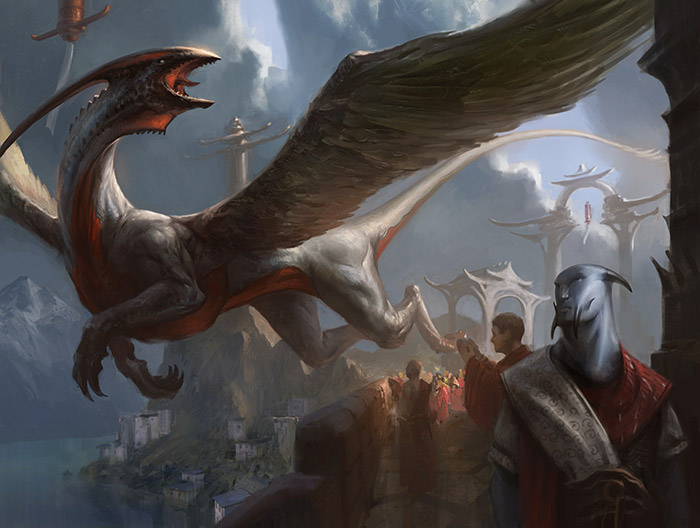
Art by Adam Paquette
Dragonspeaker. Learned Ojutai sometimes have the privilege of becoming heralds to noteworthy dragons. Occasionally, a dragon will take a human speaker and carry him or her on its shoulder or in its claws, but some dragons consider this undignified. Most prefer aven dragonspeakers for their ability to fly alongside. The herald speaks for the dragon, serving as an intermediary with lesser beings. If the dragon dies in battle, its speaker's life is forfeit, so speakers will fight to the death to defend their dragons.
Spellfists. These warriors, usually human or djinn, have trained for years to manipulate the subtle flow of magical energy. Although what they do can't properly be called spellcasting, it lends their movement and attacks a grace, speed, and fluidity that can only be described as supernatural.
Graceblades. Like spellfists, the graceblades channel energy. They do so not to empower their attacks, but to manifest mental weaponry. Becoming a graceblade requires understanding of spellfist technique and the ability to reach meditative clarity in the heat of battle.
Clan Architecture
Most sanctuaries are remote and inaccessible, built for easy travel by dragons but not land-bound creatures. Aven messengers carry missives between sanctuaries, but for other humanoids, leaving the sanctuary means an arduous and dangerous journey. Dragons are loath to carry humanoids, and never allow themselves to be ridden.
Every sanctuary, even those with no permanent dragon presence, includes open-air "runways" for dragons to land and take off, as well as a variety of perches and roosts. Doors and hallways are built big enough to accommodate even large dragons, although living quarters and practice rooms in most sanctuaries are human-scale.
Floating bells, used long ago to warn of dragon attacks, now serve as heralds of the skywise. Their pealing tells the humanoid inhabitants of a sanctuary to prepare for a visit from the honored ones.
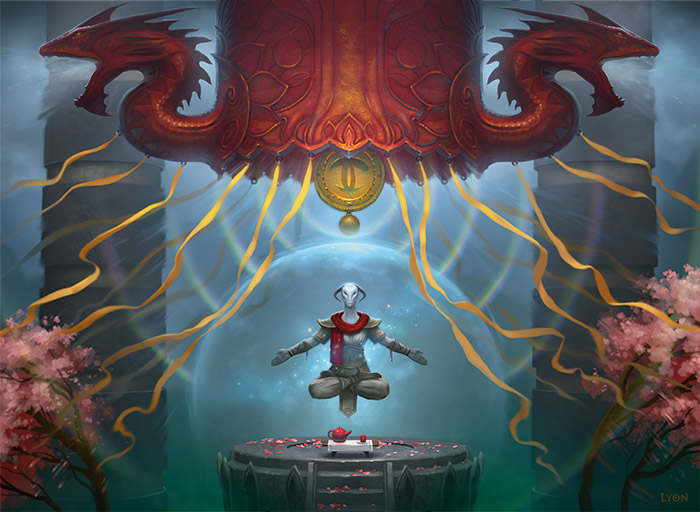
Art by Howard Lyon
Clan Locations
The Ojutai have many sanctuaries, but four loom larger than the rest in clan life.
Cori Mountain: Built inside an ancient flooded caldera, Cori Mountain Sanctuary is the primary roost and intellectual retreat of the dragonlord Ojutai. At Dragon's Eye, Ojutai expects attention. At Cori Mountain, he demands solitude to meditate and conduct research in his private chambers. Many monks at Cori Mountain take vows of silence to avoid accidentally offending the Great Teacher, and even dragons keep their distance when Ojutai is in residence.
Dragon's Eye: The secondary sanctuary and roost of the dragonlord Ojutai is built into the side of a mountain at the edge of a bay. The sanctuary is accessible by ship; via a long and difficult climb; or, of course, by wing. Ojutai can often be seen sunning himself on the vast patios of the sanctuary, with many other dragons surrounding him awaiting pearls of wisdom. The Dragon's Eye martial arts tradition is as much meditation as combat form, devoted to unlocking greater enlightenment through the union of body and mind. When pressed, however, Dragon's Eye monks are just as effective in battle as others.
Dirgur: This sanctuary, built on an island in the middle of a lake, is the destination of frequent boat traffic as well as dragons on the wing. It is the closest of the major sanctuaries to other clans' territories, which brings both caravans and raiding parties. The sanctuary's large dragon population frequently fights off attacks by the dragons of other clans. Dirgur humans are equally ready for trade or invasion, and their defense against attacks is swift and brutal.
Icefall: This sanctuary, built into the face of a cliff, preserves a trace of humans' long-ago rule. In the distant past, the sanctuary housed a massive waterwheel harnessing the power of a great waterfall. Now frozen, perhaps by the magical intervention of cold-loving Ojutai dragons, the column of ice entraps the waterwheel. Icefall martial arts devotees are staunch and unyielding, moving through a series of highly regimented martial forms.
Narset
At a young age, Narset gained the personal notice of Ojutai's himself. She attracted the dragon's attention as she would often mimic the exercises performed by both the dragons and her elders, mastering them after no more than a casual glance. Ojutai recognized hers as a mind with the potential for nearly limitless growth, so she was taken on as a student. Narset quickly mastered not only the exercises but the draconic language itself. But as Narset grew, she began to feel restless. She harbored a longing, although she was unable to identify what for, and she started to question whether or not Ojutai truly knew all the answers to the questions of life.
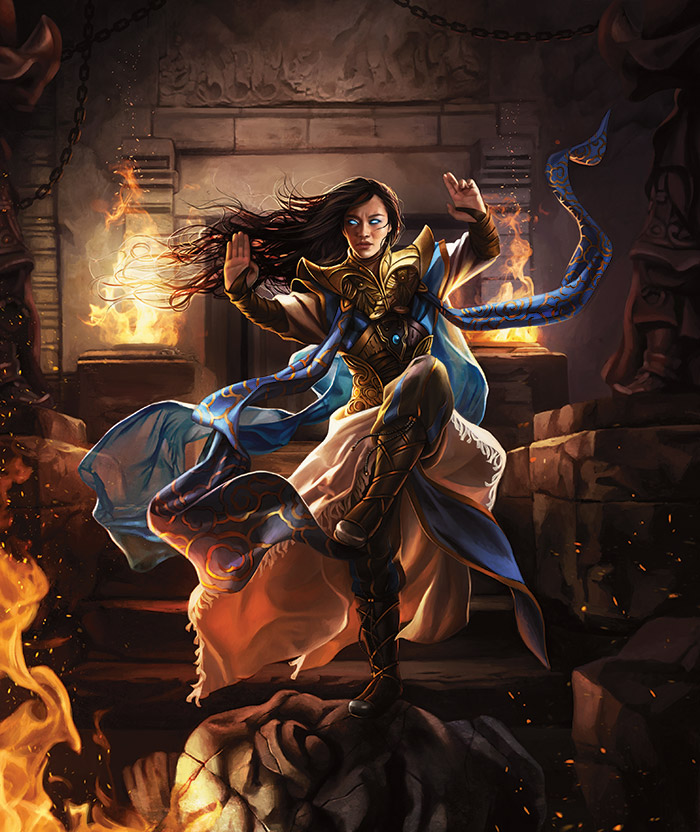
Art by Magali Villeneuve
When, in relatively short order, Narset achieved the status of master, she cared more for the autonomy that the position granted than the highly sought-after honor. She spent many a day alone, exploring the deepest and dustiest cavities in the Ojutai sanctuaries, slowly piecing together clues that illuminated the forbidden past. Her peer, Taigam, warned her of the danger in seeking out knowledge without the dragonlord's permission, but Narset saw no harm in research.
She discovered the truth of the past of Tarkir—it was not always a world ruled by dragons as the teachings of Ojutai claimed; at one time humanoid khans led mighty clans that dominated the land. Narset also learned of a powerful spirit dragon from whom all dragons were formed. It was this being that most interested her. She could feel something more in the histories that described him, something similar to her own wanderlust. She took to meditating in these secret chambers, spending hours that crept into days and even weeks without making an appearance above.
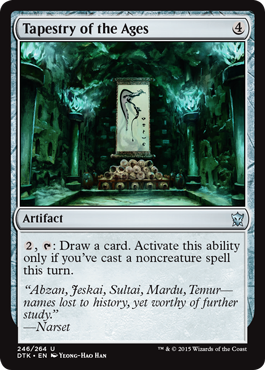
Other Clan Figures
Ishai: This female aven is Ojutai's current dragonspeaker. The ancient dragon has had many heralds and isn't personally attached to them, but Ishai has served him for many years and he grants her a great deal of autonomy and authority. Ishai's word carries the full authority of Ojutai, and where she goes, the dragonlord is often close behind.
Taigam. The male human head scholar and spellfist instructor is a man of few words. Tasked with preserving and copying the collected wisdom of the Great Teacher, he is more fluent and literate in Draconic than other humanoid alive. Although he once thought of leaving Cori Mountain Sanctuary for greater fortune in his rebellious youth, Taigam eventually saw that only Ojutai could deliver true wisdom and reaffirmed himself to the Ojutai cause.
Zhiada. The female human head warrior of Dirgur Sanctuary pays lip service to the dragons, but in truth she relies on herself and her initiates. When she was a low-ranking disciple, the garrison at Dirgur was caught off guard by a raiding party of Kolaghan disguised as a merchant crew. She personally killed the raiding party's leader, a huge orc, although the survivors fled with clan treasures. She now wears the orc's teeth strung on a necklace. Under her leadership, security at Dirgur is tight, and invaders—or even suspicious outsiders—are dealt with harshly. The artisans at Dirgur grumble that this is hurting their trade, but Zhiada insists on the security measures.
The Silumgar Clan
Clan Overview
Of the five dragonlords on Tarkir, Silumgar has the fewest followers—living followers, that is. When the undead are taken into account, his clan's numbers are unrivaled. Destructive, cruel, and murderous, Silumgar's underlings emulate their dragonlord in all that they do. The clan unapologetically embodies the draconic aspect of ruthlessness, as represented by their symbol: the fang of the dragon.
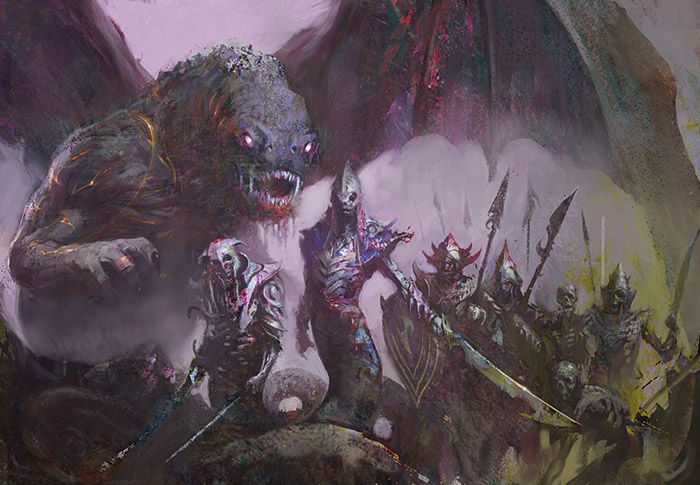
Art by Nils Hamm
Aware that their worth is measured at the whim of their capricious dragonlord, Silumgar's subjects take care to curry favor and deflect blame. Assassination and extortion are commonplace as those in the inner circle jockey and kill for position. The naga translators are often the first and fastest to gain favor. They are also the first to abuse what they have earned. The naga have been known to take liberties with their translations, thinking themselves clever. But Silumgar has his ways of discovering those who attempt to undermine or manipulate him. And he does not hesitate to purge entire networks in order to root out a few seditious individuals. His clan would do well to remember that there is a reason the dragonlord has sat atop his mountain of gold for more than a thousand years.
Dragonlord Silumgar
The dragonlord Silumgar dwells in an opulent temple-fortress surrounded by an army of dragons, mages, and undead. He enjoys provoking fights among his servants, as he derives pleasure from both the battles themselves and the resulting zombie servants, which he can then add to his horde. His ever-growing undead army gives him supreme confidence in battle, as does the fact that his underlings are nearly as infamous as he for their ruthless aggression.
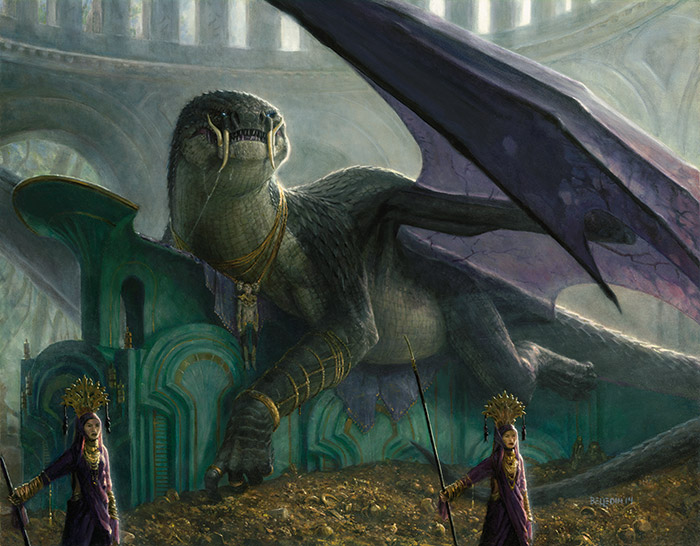
Art by Steven Belledin
Silumgar's greatest weakness is his own boredom. When his mind is not occupied by his cruel plotting, he has been known to sink into a state of paranoia. There, he obsesses over losing everything to his rival, Kolaghan. Once he is in the throes of delusion, it is nearly impossible for any to reach him. He has slaughtered masses of his own followers in fits of angst. To avoid this fatal outcome, his subjects have invented grim festivals and bloody rituals—anything to distract, soothe, or delight their dragonlord.
Clan Values
Silumgar's clan values power. For clan members, knowledge is power, so they are exceedingly clever; like the Jeskai, they hold themselves as, and take pride in, being the best educated of the clans of Tarkir. They scour the land for fragments of lost scrolls and lore. Clan necromancers order their zombie hordes to raid Jeskai temples and carry back any items of worth for Silumgar's clerics to decipher. They've even been known to carry off treasures that help guard their other treasures:
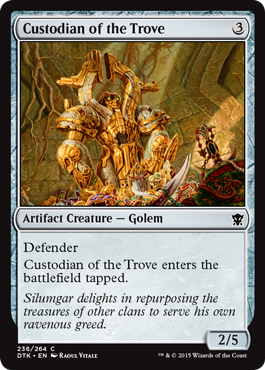
Clan Structure
The clan of ruthlessness is a top-down hierarchy with Silumgar at the top and his dragon-kind immediately below him. His human priests come next, then the warriors, and finally the servants and zombies.
Draconic, the Language of Flattery. Favored humans within the clan gain a basic understanding of the Draconic language so as to communicate their master's demands to the others. They also know that keeping the dragon happy is the key to survival, so they sing the praises of Silumgar to the fullest extent possible.
Humans, Keepers of the Dragonlord. Humans hold high positions within Silumgar's clan, which is both a blessing and a curse. To have the favor of the dragon is to live a life of opulence and power, but the dragon's fickle favor makes this lofty perch a precarious one. It is easy to fall from such grace into Silumgar's gullet.
Rakshasas, Uneasy Allies. Rakshasas are a part of the clan, with an uneasy truce between the dragons and the demons. Silumgar is smart enough to know that their powerful magic makes the rakshasas useful allies, but also dangerous enemies. The dragon's paranoia gnaws at him. He constantly fears that the rakshasas might one day prove treacherous.
Naga, the Slitherer Class. Behind closed doors, the naga claim to be related to the dragons, but in practice they hold minimal power in the clan. With her unmatched necromantic powers, the undead naga Sidisi is the only thing keeping the rest in any position of influence. Her ability to threaten, sway, and remove other politicians keeps Sidisi at Silumgar's side, whispering tales to the dragon—some to lull and some to disturb.
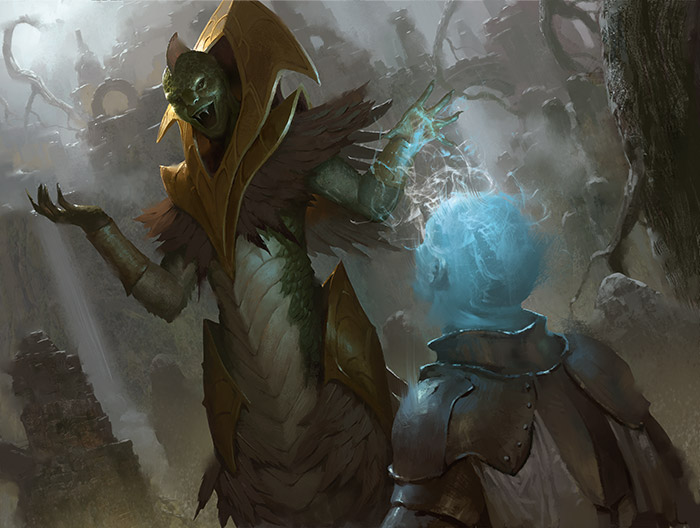
Art by Lius Lasahido
Clan Magic
Silumgar's clan still relies on the magic of necromancy and other offshoots of the dark arts such as withering, poisoning, and rot. A large part of the clan's magic comes from the repurposing of corpses. The extinct Sultai once used the cast-off bodies of other clans to create not only a tireless working class but an endless army of the dead. Although Silumgar's clan still does so in the present day, the necromancers have also found a way to enhance their arsenal of spells with unnatural power. They harvest not only the physical corpse but also the latent life-force that lingers in the dead flesh.
Clan Roles
Deathbringers. When Silumgar wants to lay waste to his enemies, he calls on these dragons. They breathe clouds of poison gas that choke armies and drool streams of acid that dissolve everything in their path.
Dragonspeakers. These humans and naga hold a high position within the clan. They are taught the rudiments of Draconic and act as interpreters for the dragonlord.
Necromasters. These necromancer dragons enhance their terrible magic by pulling the latent energy from dead flesh.
Infallible. This elite group of specially trained warriors and mages hunt dragons from other clans. Few can claim to have killed more than one, but some have slain several of the beasts.
Sibsig. The zombies used as warriors by Silumgar are known as sibsig. Unlike a risen undead, which is an animate corpse, the dark magic of Silumgar priests and necromaster dragons imbues sibsig with a twisted dark energy, making them stronger than a risen corpse.
Clan Locations
Marang River Fortress. The seat of Silumgar's power is the Marang River Fortress, where the jungle meets the mountains. Only a small, steep pass separates his domain from the lands of the dragonlord Kolaghan. Here, snowmelt from the mountains creates the great Marang River. Silumgar's dragons and restless dead patrol this place day and night. The dragonlord sleeps here, but his slumber is rarely sound.
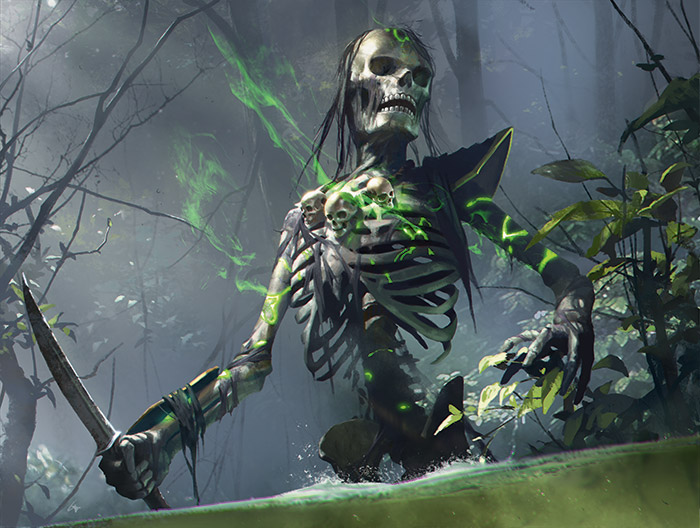
Art by Jack Wang
Qarsi Palace. Qarsi Palace is a sprawling, luxurious jungle paradise set on the waterways. This is where many Silumgar scholars and sorcerers train in their dark magic.
Ukud Necropolis. Ukud Necropolis was a massive temple designed during the time of the khans to house the fallen Sultai nobility. Now, it serves as the resting place for the bones of Silumgar's high-ranking dragons, which he has forbidden from being raised. It also serves as a vault for his treasures, often filling a dragon's tomb with mountains of jewels and gold.
Gudul. These are a series of islands that dot the massive river delta. In the waters and on the islands lurk all kinds of monsters and undead abominations that guard the inner waterways from ships and intruders that would dare invade Silumgar's domain.
Gurmag. The Gurmag Swamp are a belt of treacherous swampland that encircles part of the Silumgar domain. It is riddled with the sibsig, the wandering zombie hordes of dragonlord Silumgar, evenly composed of the fallen soldiers of rival dragonlords and Silumgar humanoids that incurred their dragonlord's wrath.
Other Clan Figures
Siara, the Dragon's Mouth. This female human is chief among the dragonspeakers. She proclaims the edicts and mandates of Silumgar and warns others of her master's mood.
Xathi the Infallible. Silumgar reserves a special human dragonslayer to kill off his most dangerous rivals. Xathi's skills have never failed the dragonlord, but Silumgar employs a cadre of ministers to keep an eye on her, fearing betrayal.
Sidisi, Undead Vizier. Although Sidisi is not a khan in this timeline, she is no less powerful. In life, she attained wealth and influence as one of Silumgar's translators, often translating Silumgar's orders in a way that most benefited her. She never directly opposed Silumgar, but when he discovered her manipulation, the paranoid dragonlord had her executed.
But dead is not gone in the Silumgar clan. The dragonlord recognized Sidisi's ruthlessness as a potent weapon, so he had her raised as an intelligent undead servant, one he could more closely control. In her life after death, Sidisi has been able to rally the naga and gain the allegiance of a large number of sibsig zombies. For now, she sits on the leverage she has attained; for now, she remains loyal to Silumgar.
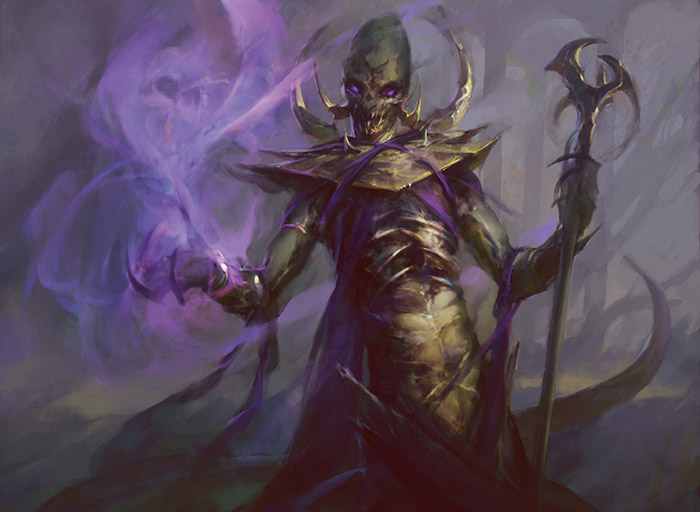
Art by Min Yum


